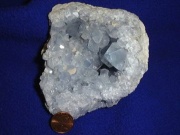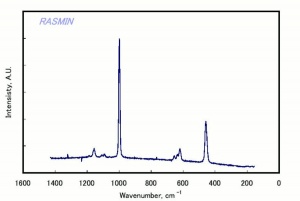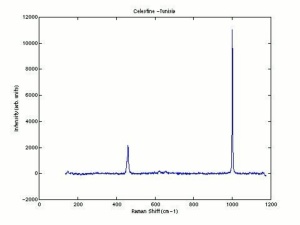Difference between pages "Celestial blue" and "Celestite"
(Difference between pages)
Jump to navigation
Jump to search
| Line 1: | Line 1: | ||
| + | [[File:celestiteemr1.jpg|thumb|Celestite (strontium sulfate)]] | ||
== Description == | == Description == | ||
| − | A | + | A pale blue naturally occuring mineral composed of [[strontium sulfate]]. Celestite is found in sedimentary stone usually in conjunction with [[halite]] and [[dolomite|dolomitic limestone]]. Specimens have been found in England (Bristol), Italy (Sicily), Mexico (Matehuala) and the U.S.(Ohio, California). Celestite is mined as a source of strontium. It is also used in the manufature of ceramics, glass, and fireworks. |
== Synonyms and Related Terms == | == Synonyms and Related Terms == | ||
| − | + | celestine; strontium sulfate | |
| + | |||
| + | [[[SliderGallery rightalign|celestiteRS.jpg~Raman|Celestineitaly1.jpg~Raman]]] | ||
| + | |||
| + | ==Physical and Chemical Properties== | ||
| + | |||
| + | * Orthorhombic system with tabular | ||
| + | * Perfect cleavage in one direction; good in two directions. | ||
| + | * Fracture = uneven. | ||
| + | * Luster = vitreous to pearly. | ||
| + | * Streak = white | ||
| + | * Mohs Hardness =crystals. | ||
| + | * Sometimes fluorescent. 3.0 - 3.5 | ||
| + | * Density = 3.9-4.0 g/ml | ||
==Resources and Citations== | ==Resources and Citations== | ||
| − | * | + | * Mineralogy Database: [http://www.webmineral.com/data/Celestine.shtml Celestine] |
| + | |||
| + | * ''Encyclopedia Britannica'', http://www.britannica.com Comment: "celestite." Accessed 8 Dec. 2004. | ||
| + | |||
| + | * C.W.Chesterman, K.E.Lowe, ''Audubon Society Field Guide to North American Rocks and Minerals'', Alfred A. Knopf, New York, 1979 | ||
| + | |||
| + | * Wikipedia: http://en.wikipedia.org/wiki/Celestite (Accessed Sept 2, 2005) | ||
| − | * | + | * ''The Merck Index'', Martha Windholz (ed.), Merck Research Labs, Rahway NJ, 10th edition, 1983 |
[[Category:Materials database]] | [[Category:Materials database]] | ||
Latest revision as of 09:14, 24 May 2022
Description
A pale blue naturally occuring mineral composed of Strontium sulfate. Celestite is found in sedimentary stone usually in conjunction with Halite and dolomitic limestone. Specimens have been found in England (Bristol), Italy (Sicily), Mexico (Matehuala) and the U.S.(Ohio, California). Celestite is mined as a source of strontium. It is also used in the manufature of ceramics, glass, and fireworks.
Synonyms and Related Terms
celestine; strontium sulfate
Physical and Chemical Properties
- Orthorhombic system with tabular
- Perfect cleavage in one direction; good in two directions.
- Fracture = uneven.
- Luster = vitreous to pearly.
- Streak = white
- Mohs Hardness =crystals.
- Sometimes fluorescent. 3.0 - 3.5
- Density = 3.9-4.0 g/ml
Resources and Citations
- Mineralogy Database: Celestine
- Encyclopedia Britannica, http://www.britannica.com Comment: "celestite." Accessed 8 Dec. 2004.
- C.W.Chesterman, K.E.Lowe, Audubon Society Field Guide to North American Rocks and Minerals, Alfred A. Knopf, New York, 1979
- Wikipedia: http://en.wikipedia.org/wiki/Celestite (Accessed Sept 2, 2005)
- The Merck Index, Martha Windholz (ed.), Merck Research Labs, Rahway NJ, 10th edition, 1983


